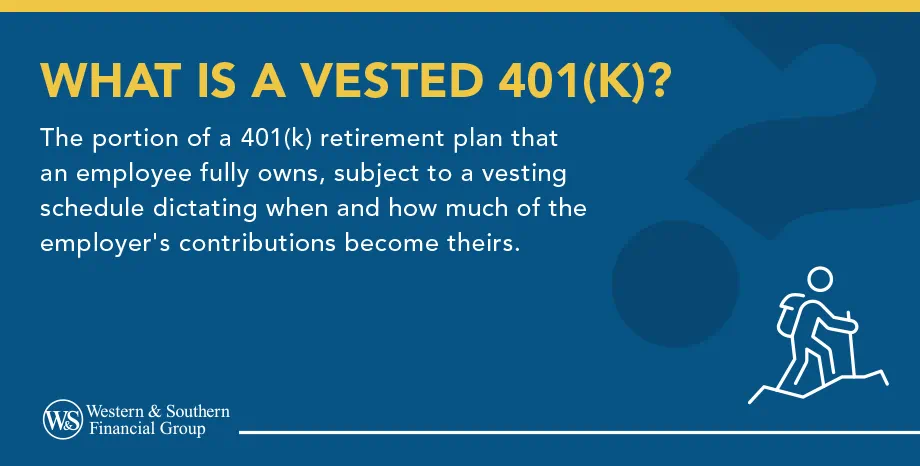

Key Takeaways
- Vesting is gaining ownership of company 401(k) contributions, while your contributions are always 100% vested.
- Employers can use vesting plans like "cliff vesting" for full ownership after a set time or "graded vesting" for gradual ownership over six years.
- Safe Harbor 401(k) plans allow employees to access and use all employer contributions immediately.
- When you leave your job, you can take your vested 401(k) funds with you, typically rolling them over to another 401(k) or IRA, while unvested funds are usually lost per the plan's rules.
When your job offers a 401(k) plan, your employer might help you save by also contributing to the plan on your behalf. Those matching or profit-sharing contributions are a nice bonus, but you can typically only take vested 401(k) contributions with you when you leave an employer. As a result, it can be important to understand how vesting works and track when the money becomes fully vested.
What Is Vesting?
Vesting is the process of gaining ownership rights to money your employer contributed to your retirement plan, according to the IRS.1 401(k) contributions are 100% vested, but match and profit sharing contributions require vesting.
As you reach vesting milestones, you "own" increasingly more of the money in your account, and your employer loses the right to reclaim that money if you stop working for them. Once you're 100% vested, you own all of the money your employer has contributed to your 401(k) account.
Employers often add money to your 401(k) through matching, profit sharing and other types of contributions. However, that employer money might come with strings attached — you may need to stay with the employer for a specified amount of time to fully benefit from those contributions.
If you are not 100% vested, you might not be allowed to access the total amount of money contributed to your account by your employer. For example, if you have $10,000 of profit-sharing money in your account, but you're only 80% vested, you would likely receive just $8,000 of that $10,000 balance.
How 401(k) Vesting Works
Money in your 401(k) account vests over time, depending on your plan rules and the types of contributions that go into your plan.
- Your contributions: Money you contribute from your paycheck is always 100% vested. Vesting schedules only apply to money your employer puts into your account.
- Immediate vesting: Safe harbor 401(k)s are similar to traditional 401(k)s, but with this type of plan, employer contributions are immediately 100% vested, according to the IRS.2
- Common vesting schedules: Vesting schedules often provide ownership after several years of employment. For example, you might receive credit for one year of service when you work 1,000 hours in a calendar year. Two standard vesting schedules include:
- Three-year cliff vesting: You are 0% vested for the first two years. After three years of service, your vested 401(k) balance is 100%.
- Graded vesting period: You are 0% vested for the first year, and you earn 20% for each subsequent year, becoming 100% vested in year six.
You can likely find your plan's vesting rules and schedule in your 401(k)'s summary plan description (SPD).
Visualize your savings’ potential with our 401(k) Calculator. Calculate Savings
What Happens When You Leave Your Job?
When you stop working for your employer, you can typically take vested funds with you. For example, you might rollover that money to another 401(k) or individual retirement account (IRA). You likely will have to forfeit any unvested money in a 401(k) plan when you leave your job. The vesting level of a plan determines the amount of funds received.
But any remaining (unvested) money is forfeited and used in accordance with the plan documents. Some plans allow the forfeited amount to be used to pay administrative expenses, and others use it to offset plan contributions or allow for reallocation to current plan participants.
Why Do Plans Use Vesting?
Vesting schedules are appealing to employers for a number of reasons. Here are a few of the common ones:
- Helping to reduce turnover: A vesting schedule provides an incentive for employees to stay longer. If you're tempted to change jobs — but you know you could receive extra retirement assets if you stay where you are — you have an incentive to keep working for the same employer.
- Rewarding employees: Rather than not matching contributions at all, a vesting schedule may make companies more willing to help employees build their retirement savings.
- Helping to keep costs low: When you forfeit unvested funds, your employer can use that money in a variety of ways, depending on plan rules. The company might spend that money on administrative expenses to run the 401(k) plan, or they might redirect those funds to other employees.
The Bottom Line
Vesting schedules determine how much you're entitled to take with you when you leave your employer. Your contributions are 100% vested, but employer money might be subject to a vesting schedule that lasts several years. Consider studying your plan rules to understand if there's any delay in vesting, and then tracking your years of service so you know where you stand.
Optimize your retirement by managing your vested contributions. Start Your Free Plan
Frequently Asked Questions
What is the difference between vested and unvested 401(k) funds?
How long does it take to become fully vested in a 401(k) plan?
Can I withdraw my vested 401(k) balance before retirement?
What are the tax implications of withdrawing money from a vested 401(k) account?
Sources
- Retirement Topics - Vesting. https://www.irs.gov/retirement-plans/plan-participant-employee/retirement-topics-vesting.
- 401(k) Plan Overview. https://www.irs.gov/retirement-plans/plan-sponsor/401k-plan-overview.



















